Chè Ba Màu, which translates to "Three-Color Dessert," is a popular and refreshing Vietnamese dessert. “Che” is the Vietnamese word for any kind of sweet drink, soup or pudding. As Chè Ba Màu’s name suggests, this dessert is characterized by its three distinct layers of vibrant colors (it’s really actually four layers, if you include the ice). You can make the components for this treat ahead of time, so that it’s effortless to throw together whenever you want a refreshing sweet, to chill with after a plate of Vietnamese noodles.

Chè Ba Màu is often made using artificial coloring and extracts, but this recipe is 100% natural, vegan, and it also happens to be gluten-free.
The bottom layer consists of dark beans. In Vietnam, either glutenous black beans, red kidney beans, or adzuki beans are used. The soft, slightly chewy texture of the beans drenched in the cold sugar syrup provides a delightful contrast to the other components of the dessert.
On top of the black bean layer, you'll find a generous serving of mung beans with creamy sweetened coconut milk.
The crowning glory of Chè Ba Màu is the third layer, made with pandan-infused jelly cubes or strips. The natural vibrant green color is not only attractive, but also provides a refreshing and mildly sweet taste with a pleasant herbal aroma. The combination of textures between the smooth jelly and the other layers creates a unique sweet treat, that stands out from other Southeast Asian classic desserts such as martabak manis , and banh flan.

Chè Ba Màu is served chilled, loaded with crushed ice and coconut cream, making it a perfect dessert to beat the heat during hot summer days. Move over ice cream, you are gone, throw your reputation in da TWASHCAN! This banger right here is light and refreshing, making it an excellent choice for those who prefer desserts that are not overly heavy and cloyingly sweet.
Jump to:
🥰Why you are going to fall in love with this recipe
- Reliable as heck: This recipe has undergone rigorous testing, to just by me, but also by my team of recipe testers, ensuring that the instructions are accurate, reliable, and yield excellent results o matter what brand of coconut milk you use, or where in the world you make it. The recipe's reliability is unmatched!
- Vegan, natural, and gluten-free: Chè Ba Màu is a dessert that by design does not use any animal products, making it a compassionate and cholesterol-free choice. My recipe doest rely on pandan extract, which almost always contains artificial colors. Instead, my pandan jelly, which has a more natural muted color has the full flavor and fragrance of real pandan leaves. Furthermore, the recipe is gluten-free, and since I know you hate gluten with all of your heart, and you scream every time you see a majestic field of wheat… well, this dessert will not anger you. So, that’s good right?
- Protein-packed: Unlike many desserts that are primarily composed of refined sugars and unhealthy fats, Chè Ba Màu offers a noteworthy protein content! The inclusion of adzuki and mung beans provide a nutritious aspect to this delightful treat.
- Great for folks with no time, or limited skill: Chè Ba Màu is a dessert that doesn't demand extensive cooking skills or a significant investment of time. The preparation involves simple techniques such as cooking the beans, preparing the coconut milk layer, and making the pandan jelly cubes. With concise instructions and minimal cooking, this recipe is accessible to both experienced and novice cooks alike.
🫘Notable ingredients and substitutions

Agar Agar
Agar agar powder, also known as "rồng biển" in Vietnamese, is derived from seaweed and is a popular ingredient in Asian desserts. It is produced by boiling and drying red algae, producing a mostly tasteless and odorless gelatin substitute. Agar agar is a great vegan alternative to traditional gelatin, which is made from animal collagen, and is also the polysaccharide (complex carbohydrate composed of multiple sugar molecules) used to create the nutrient substrate food in petri dishes and slants. If agar agar powder is not available, you can substitute it with agar agar flakes or Irish moss.
Pandan
Pandan leaves, or "lá dứa" in Vietnamese, are widely used in Southeast Asian desserts (like klepon and kuih dadar) for their distinct fragrance and flavor. The long, slender leaves infuse dishes with a unique sweet, herbal, floral aroma. If pandan leaves are not available, you can substitute them with a good quality natural pandan extract.
Split Mung Beans
Yellow mung beans, also called "đậu xanh" in Vietnamese, are a staple ingredient in Vietnamese cuisine, particularly in desserts. These tiny legumes are obtained by removing the outer green shell and splitting the bean into halves. If you can’t get peeled mung beans, you can substitute them with split yellow lentils or chana dal, but both will require a bit more cooking time, as they are larger and denser.
Adzuki Beans
Adzuki beans, known as "đậu đỏ" in Vietnamese, are small red beans with a slightly sweet flavor. They are commonly used in Asian desserts and have a rich cultural significance in Japan and China. If adzuki beans are not available, you can substitute them with kidney beans or black beans, both of which are commonly used in Che Ba. You can also replace them with pre-made red bean paste, or canned sweetened mashed red beans, both of which are common in authentic che ba recipes.
Shaved Ice
I know, it seems crazy to have to explain ice as an ingredient, but it matters here, so listen up! Don’t just use crushed ice from your refrigerator’s ice maker. Place ice cubes in a blender or food processor and grind them almost into dust. You want an almost snow-like consistency for Chè Ba Màu. If you don’t have a blender or food processor, you can also place ice cubes in a bag, and then place the bag under a kitchen towel before busting the heck out of the ice with a mallet, hammer, or the side of a rolling pin.
📖How to make che ba
Ready to learn how to make your new favey refreshing dessert? I will walk you through the whole process. Or you can follow along with the easy-to-print recipe card towards the bottom of this page.
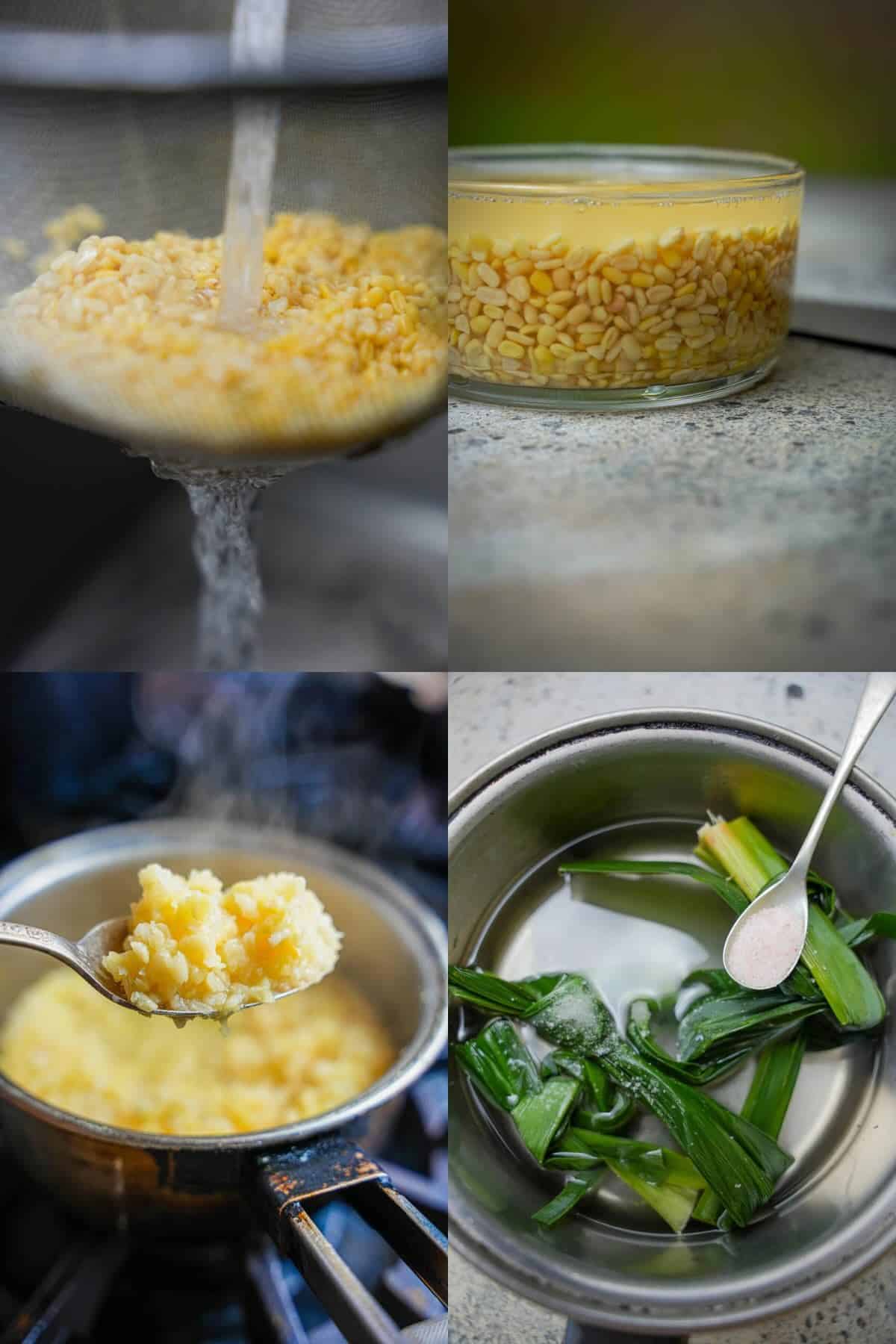
Step 1
Begin by rinsing the split, hulled mung beans under cold water.
Step 2
Soak the mung beans for at least two hours or overnight to soften them.
Drain the mung beans and rinse them thoroughly using a wire mesh strainer or colander.
Step 3
In a saucepan, add the rinsed mung beans and cover them with water. Bring the mixture to a boil over high heat. Once boiling, reduce the heat to low, cover the pot with a lid, and simmer until the beans are soft, most of the water has evaporated or been absorbed, and they can be easily mashed. If desired, you can leave the beans whole or use a potato masher to achieve a smoother consistency.
Step 4
In another saucepan over medium heat, combine water, pandan leaves, salt, agar agar, and sugar. Bring the mixture to a boil, stirring occasionally.
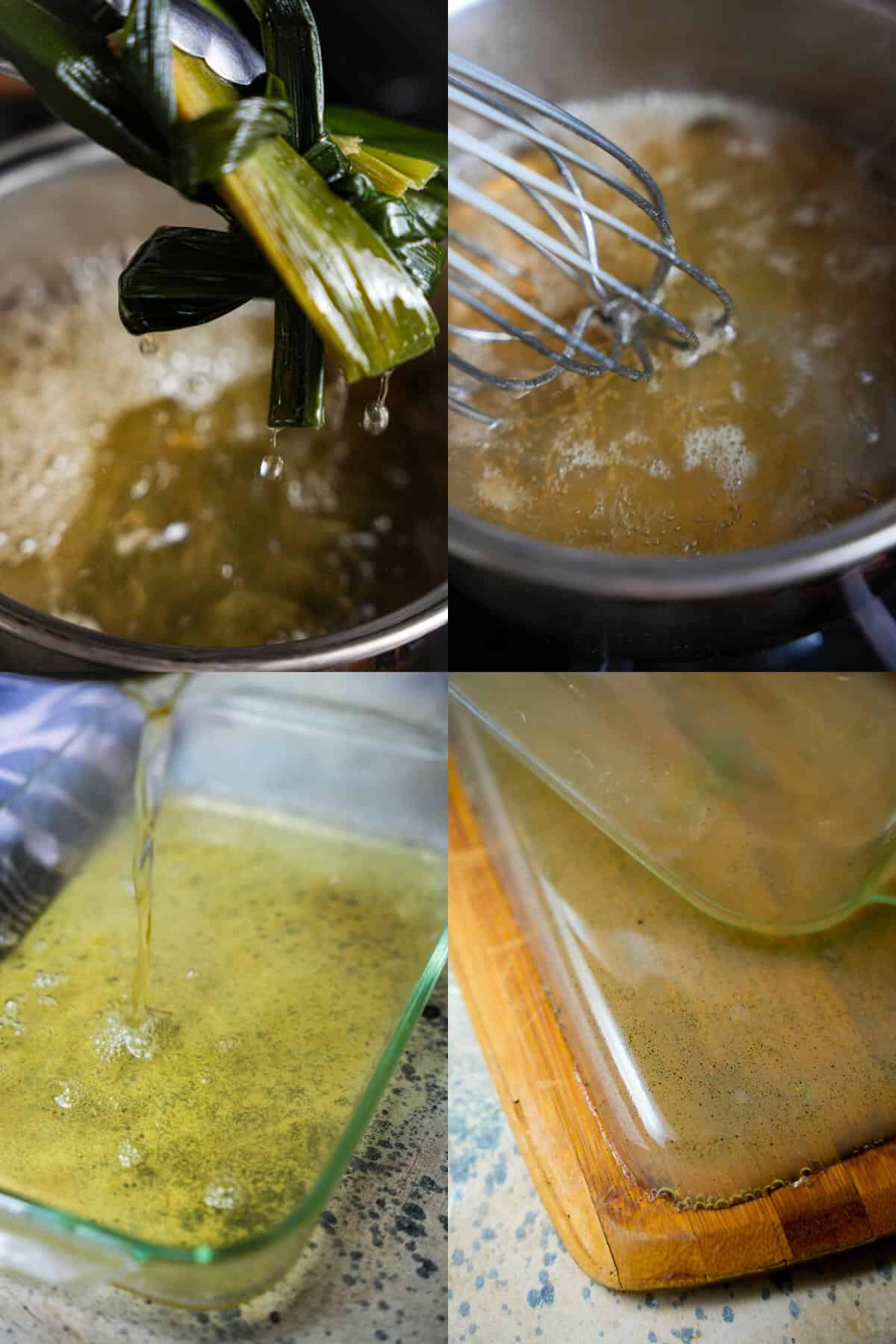
Step 5
When the water is visibly greenish and fragrant, remove the pandan leaves, and whisk in the agar agar.
Step 6
Reduce the heat and simmer for 5 minutes to thicken the liquid, while continuing to whisk so that no lumps develop.
Step 7
Pour the mixture into a shallow glass dish or mold and refrigerate for approximately one hour until it sets firmly.
Step 8
Once set, score around the edges of the pan with a knife to loosen it and flip the thick jelly out onto a cutting board.
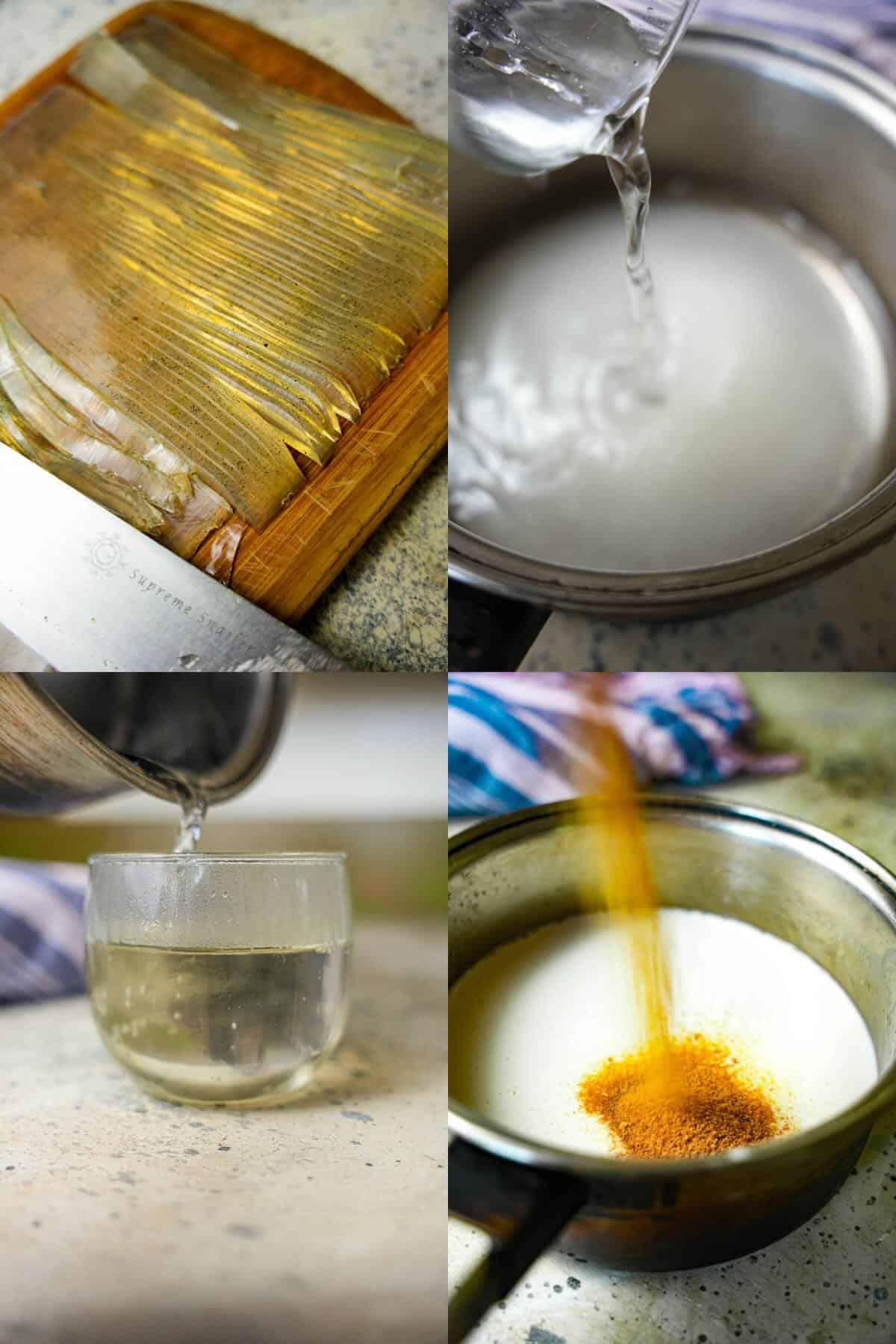
Step 9
Cut the pandan jelly into thin strips or small cubes and set them aside.
Step 10
In a small saucepan, combine sugar and water to make the syrup. Bring the mixture to a boil over medium heat, stirring until the sugar is completely dissolved.
Step 11
Remove the syrup from the heat, and pour it into a bowl or cup to cool.
Step 12
In a saucepan over medium heat, combine the coconut cream and sugar. Stir until the sugar is dissolved and the coconut cream is smooth. Set aside to cool.
➡️ You can also use this coconut sauce on tupig, a steamed banana leaf-wrapped rice sweet from the Philippines.
Che Ba Mau Assembly Instructions

Step 13
In serving glasses or bowls, begin the layering process by adding a generous amount of shaved ice at the bottom.
Step 14
Spoon a layer of the adzuki beans on top of the shaved ice.
Step 15
Spread a layer of the mushy mung beans evenly over the adzuki beans.
Step 16
Add a generous handful of pandan jelly cubes and strips on top.

Step 17
Place another large scoop of crushed ice over the pandan layer.

Step 18
Drizzle the syrup generously over the layers.
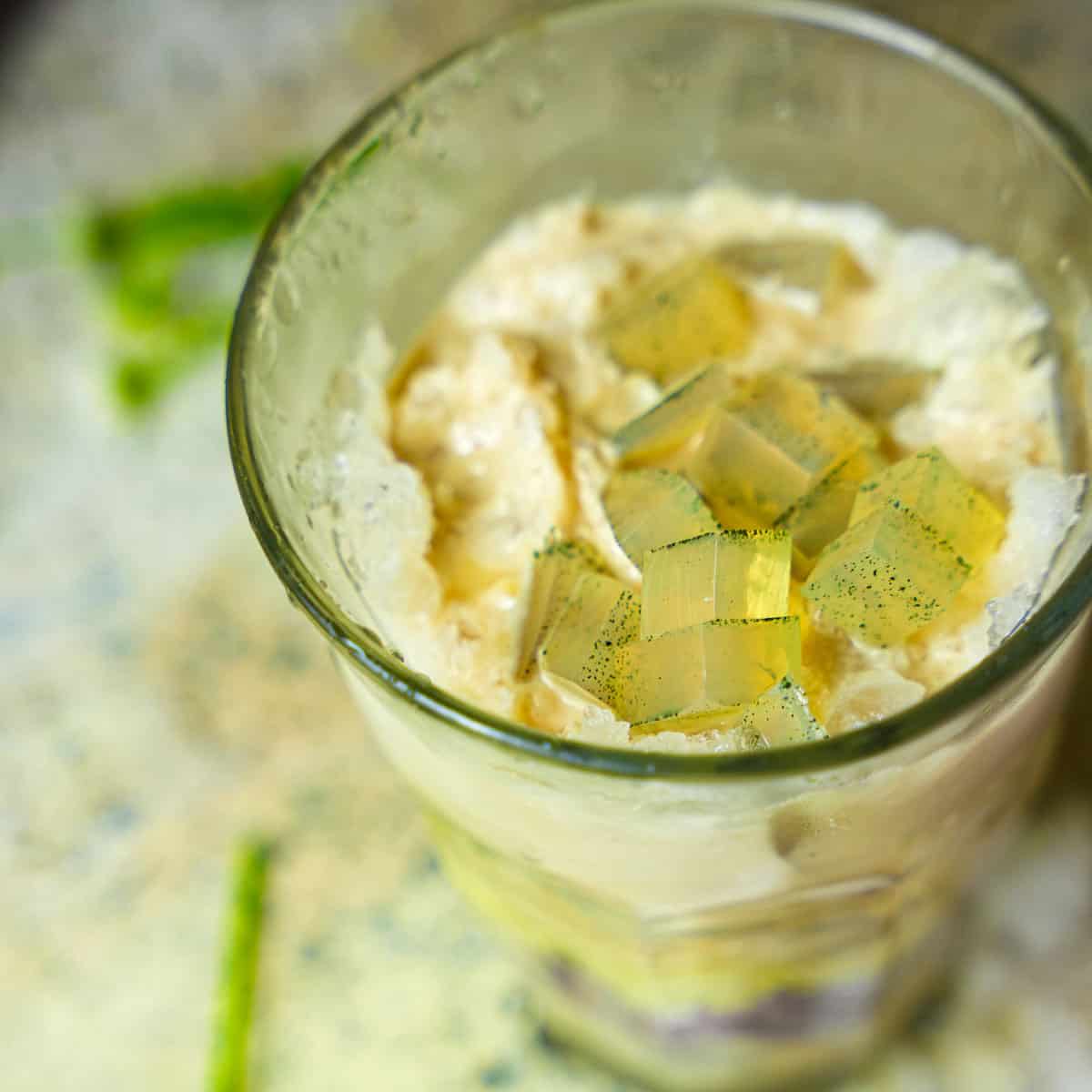
Step 19
Finish the assembly by adding a generous dollop of sweetened coconut sauce on top. Add extra ice and pandan “just for fun” because it makes the dessert a bit cuter.
Repeat the layering process for additional servings.
Serve the Chè Ba Màu immediately to enjoy its refreshing flavors while cold.
🍽️Serving Ideas
Chè Ba Màu makes a lovely dessert after the following Asian meals:
If you're in the mood for Indonesian cuisine, consider serving Lontong Sayur Lodeh, a flavorful vegetable curry with compressed rice cakes. Ketoprak, a traditional Indonesian salad with rice vermicelli, tofu, and peanut sauce, also pairs well. For a taste of Betawi cuisine, serve Fried Tofu and Nasi Uduk Betawi, fragrant coconut pandan rice with various side dishes.
Bami Goreng, a delicious Indonesian-Chinese stir-fried noodle dish, or Mie Goreng, a popular Indonesian fried noodle dish, would be excellent choices. Thai cuisine lovers will enjoy Pad Woon Sen, a stir-fried glass noodle dish packed with vibrant flavors.
For a delightful Cantonese treat, serve Crispy Rice Dumplings, a delicious savory snack made with glutinous rice and red jujube dates. Lastly, Chee Cheong Fun, a classic Cantonese dish consisting of steamed rice noodle rolls, can add a touch of indulgence to the meal.
If you are into other pretty colorful desserts, you will love bubur cha cha, and buber sum sum made with bright orange biji salak dumplings.
🤷♀️Recipe FAQs
Chè Ba Màu is a Vietnamese three color dessert with layers of mung beans, red beans or sweetened red bean paste, and green pandan jelly, topped with shaved ice, syrup, and sweetened coconut cream. It is a visually appealing cold treat that reflects Vietnam's culinary heritage.
Halo-halo, which translates to “mix-mix” in Tagalog, is a Filipino dessert that combines various ingredients like fruits, jellies, sweetened beans, coconut, leche flan, and crushed or shaved ice. The mixture is served in a glass or bowl, creating a colorful and textured medley of flavors. Toppings can include ube jam, nata de coco, pinipig, and ice cream. Halo-halo offers more flexibility in terms of variations and toppings, allowing for a diverse and delightful dessert experience.
The Malaysian dessert that shares similarities with Chè Ba Màu is known as "Ais Kacang" or "ABC" (Ais Batu Campur). Ais Kacang is a popular icy dessert enjoyed in Malaysia, especially during hot weather.
Like Chè Ba Màu, Ais Kacang features a combination of colorful and varied ingredients. It typically consists of a mound of shaved ice topped with an assortment of sweet ingredients. These can include red beans, corn kernels, grass jelly, palm seeds, agar-agar jelly, attap chee (nipah palm fruit), and syrup. Evaporated milk is often drizzled over the mixture to add creaminess.
To be able to make Chè Ba Màu at a moment's notice, it's helpful to store the components separately under refrigeration.
Yellow mung Bean Layer: Once cooked and cooled, transfer the mung bean layer to an airtight container or a resealable bag. Store it in the refrigerator for up to 3-4 days. Before using, bring it to room temperature or gently reheat it in a saucepan.
Red Bean Layer: Keep the red beans canned until you need to use them!
Pandan Jelly Layer: After cutting the pandan jelly into cubes or strips, place them in a container with a tight-fitting lid and store in the refrigerator.
Syrup: Allow the syrup to cool completely before transferring it to a sealed container. Store it in the refrigerator for up to 1-2 weeks. Give it a quick stir before using it to ensure the sugar is evenly distributed.
Sweetened Coconut Cream: If you have any leftover sweetened coconut cream, transfer it to an airtight container and refrigerate. Stir well before using, as the coconut cream may separate when chilled.
Shaved Ice: While you can't store shaved ice for a prolonged period, you can keep a bag of ice cubes in your freezer to have on hand. When ready to make Chè Ba Màu, simply crush the ice cubes using a blender or food processor, or a manual ice shaver.
✌️My favey dishes to serve with che ba:
Say Hi on Social! 👋
Follow me on Instagram & Facebook for more recipes.
❤️Love this recipe? It helps me out greatly if you leave a 5-star 🌟🌟🌟🌟🌟rating in the recipe card below and maybe even leave me a lovey-dovey comment too!
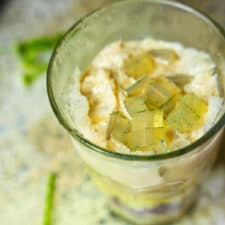
Chè Ba Màu | Cold Three-Color Vietnamese Dessert
Ingredients
Mung bean layer
- ½ cup mung beans (split and hulled, yellow moong dal)
- 1 ¼ cup water
Red bean layer
- 15 oz. adzuki beans (canned) or red kidney beans, or black beans, drained and rinsed
Pandan jelly
- 2 cups water
- 3 pandan leaves
- ¼ teaspoon salt
- 2 ½ teaspoons agar agar powder
- 2 tablespoons sugar
Syrup
- ½ sugar
- ½ cup water
Sweetened coconut cream
- 13.5 oz. canned coconut cream
- 2 tablespoons sugar
Ice
- 3 cups shaved ice
Instructions
Prep:
- Rinse the split, hulled mung beans under cold water.
- Soak the mung beans for a minimum of 2 hours, or overnight.
- Drain the mung beans and rinse them in a wire mesh strainer or colander.
- In a saucepan, add the rinsed mung beans and cover with the water. Bring to a boil over high heat. Place a lid on the pot and lower the flame cook until the beans are soft, most water has evaporated or been absorbed and easily mashed. You can either leave them whole, or mash them with a potato masher if you prefer that consistency.
- In a saucepan, add water, pandan leaves, salt, agar agar, and sugar. Bring to a boil over medium heat.
- Reduce the heat and simmer for five minutes to infuse the pandan flavor into the water, while occasionally whisking.
- Pour the mixture into a shallow glass dish or mold. Refrigerate for one hour until set.
- Once set, cut the pandan jelly into thin strips and small cubes and set aside.
- In a small saucepan, combine sugar and water for the syrup.
- Bring to a boil over medium heat, stirring until the sugar is completely dissolved.
- Remove from heat and set aside to cool.
- In a saucepan over medium heat, combine the coconut cream and sugar. Stir until the sugar is dissolved and the coconut cream is smooth. Set aside to cool.
Assembly:
- In serving glasses or bowls, layer the shaved ice, starting with a generous amount at the bottom.
- Add a spoonful of the mung bean layer on the shaved ice.
- Layer with the red bean paste, distributing it evenly.
- Add a generous handful of pandan jelly cubes and strips on top.
- Place another large scoop of crushed ice over the pandan layer.
- Drizzle the syrup over the layers.
- Finish with a generous dollop of sweetened coconut cream on the top.
- Repeat the layering process for additional servings.
- Serve immediately and enjoy the refreshing Chè Ba Màu!
Notes
- Soaking the mung beans for longer than two hours helps to soften them more, reducing the cooking time.
- Keep an eye on the mung beans while simmering to prevent them from sticking to the bottom of the pan.
- Adjust the thickness of the pandan jelly by cutting it into different shapes and sizes according to your preference. You can use tiny heart or star-shaped cutters or a small Mellon baller for different funky shapes.
- To make the pandan jelly easier to handle, lightly oil the knife or scissors before cutting.
- Ensure the syrup has completely cooled before drizzling it over the layers to prevent the ice from melting quickly.
- Serve the Chè Ba Màu immediately after assembly to maintain the perfect balance of textures and flavors.

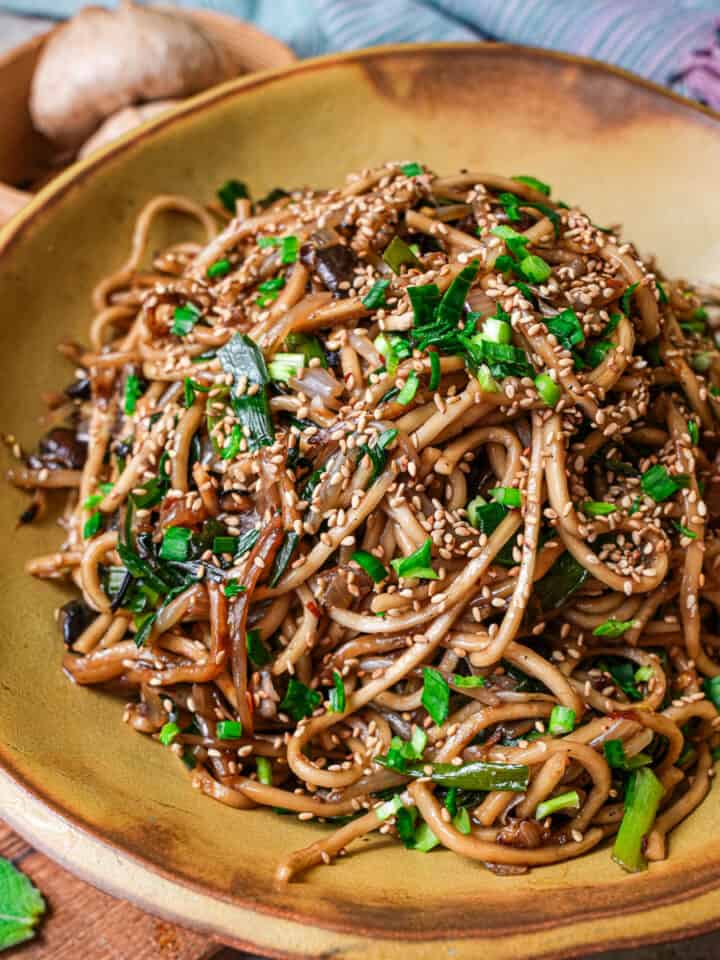
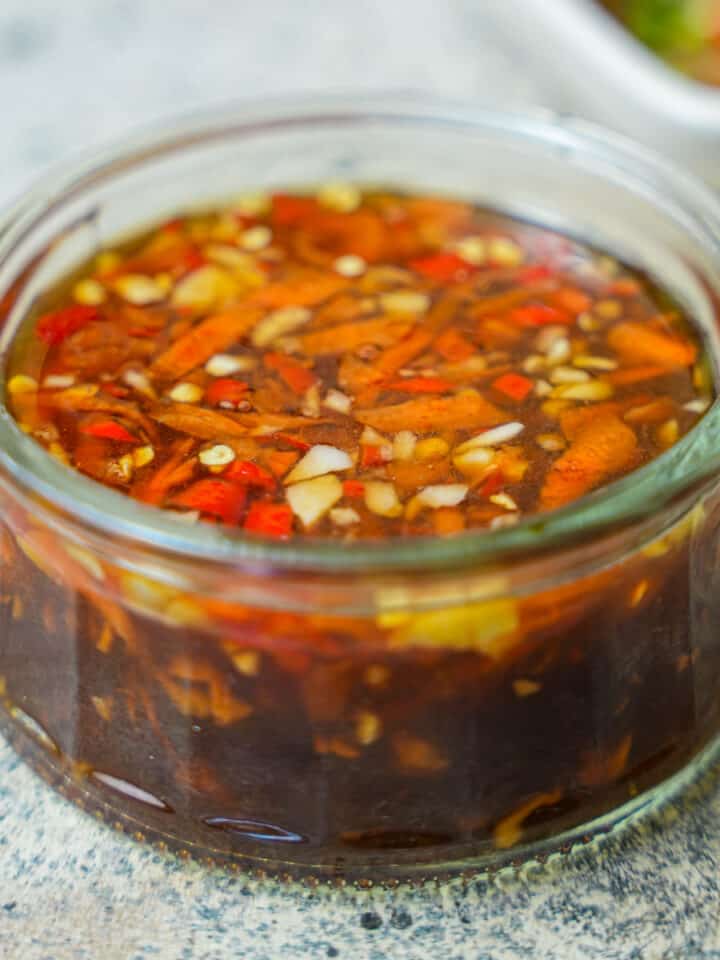
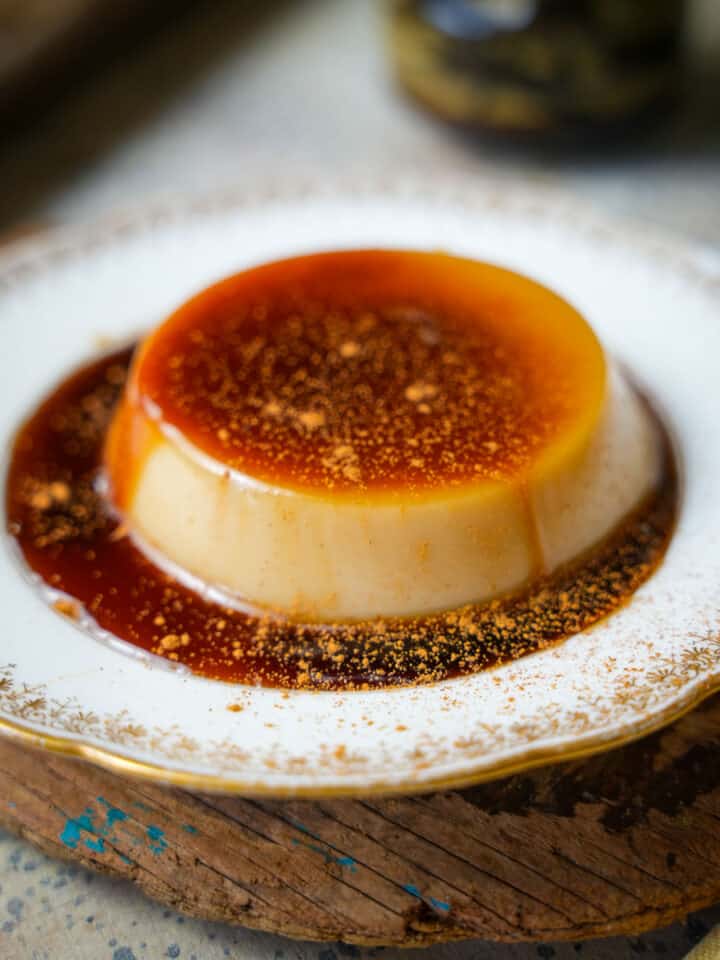
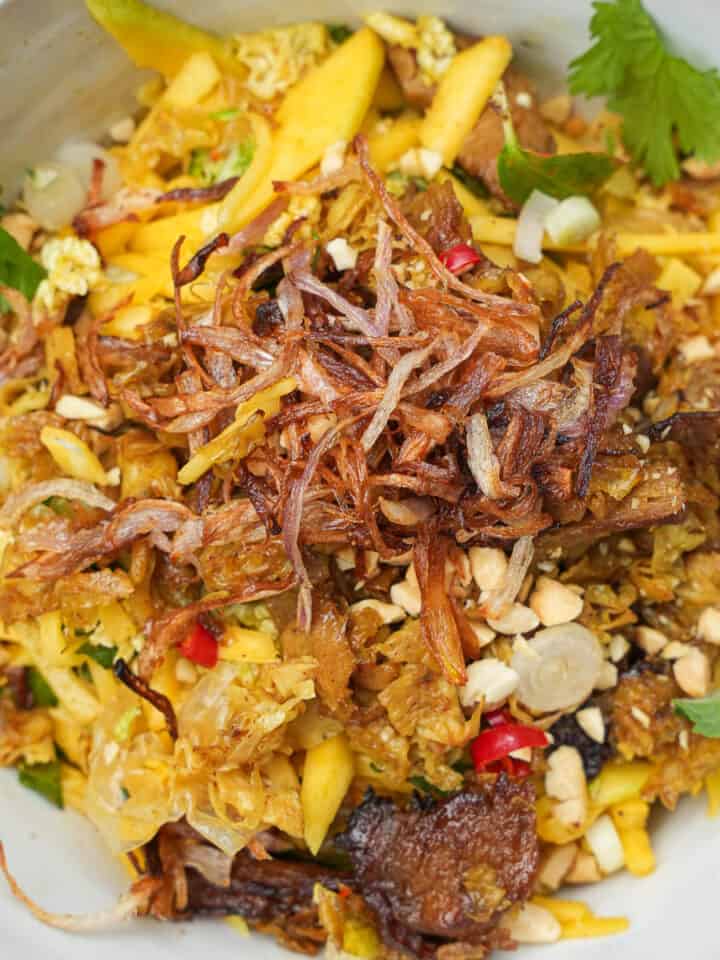
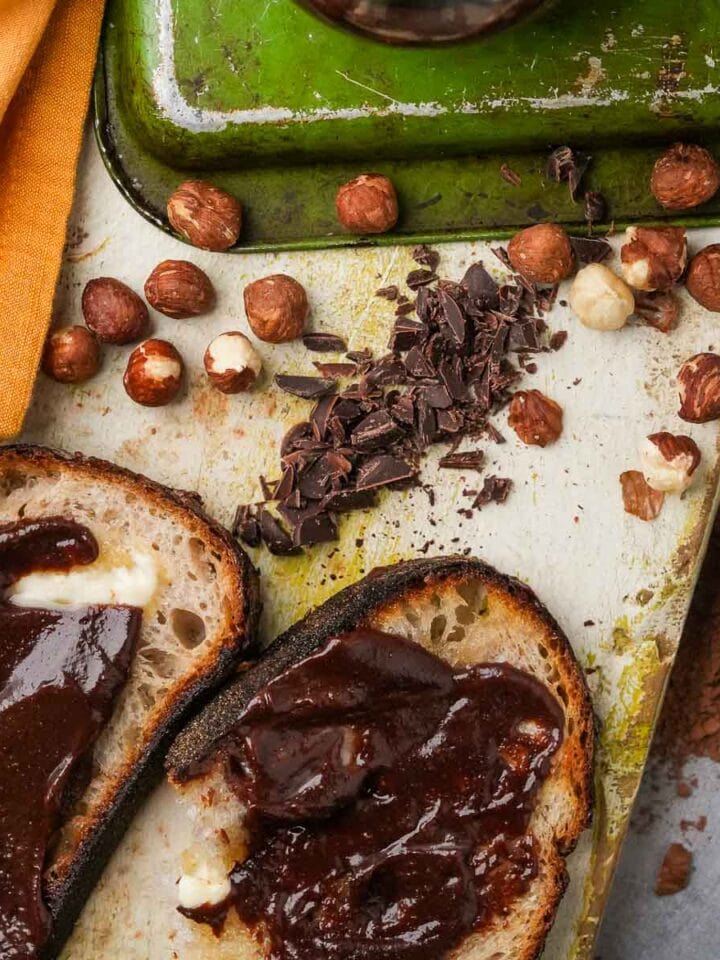
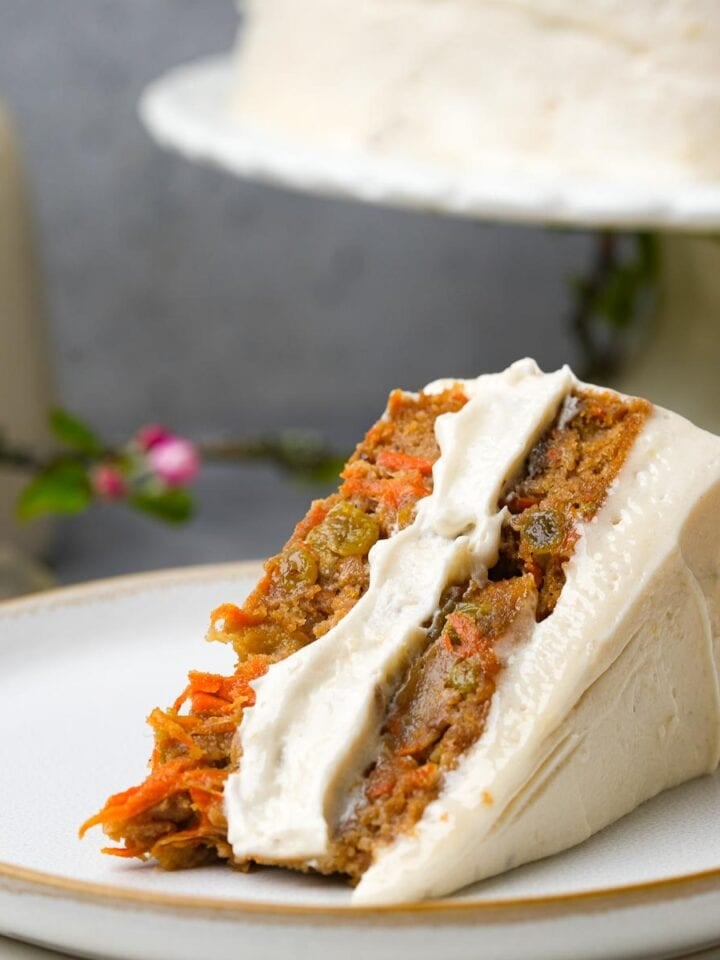



Leave a Reply